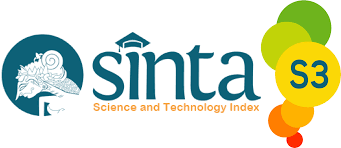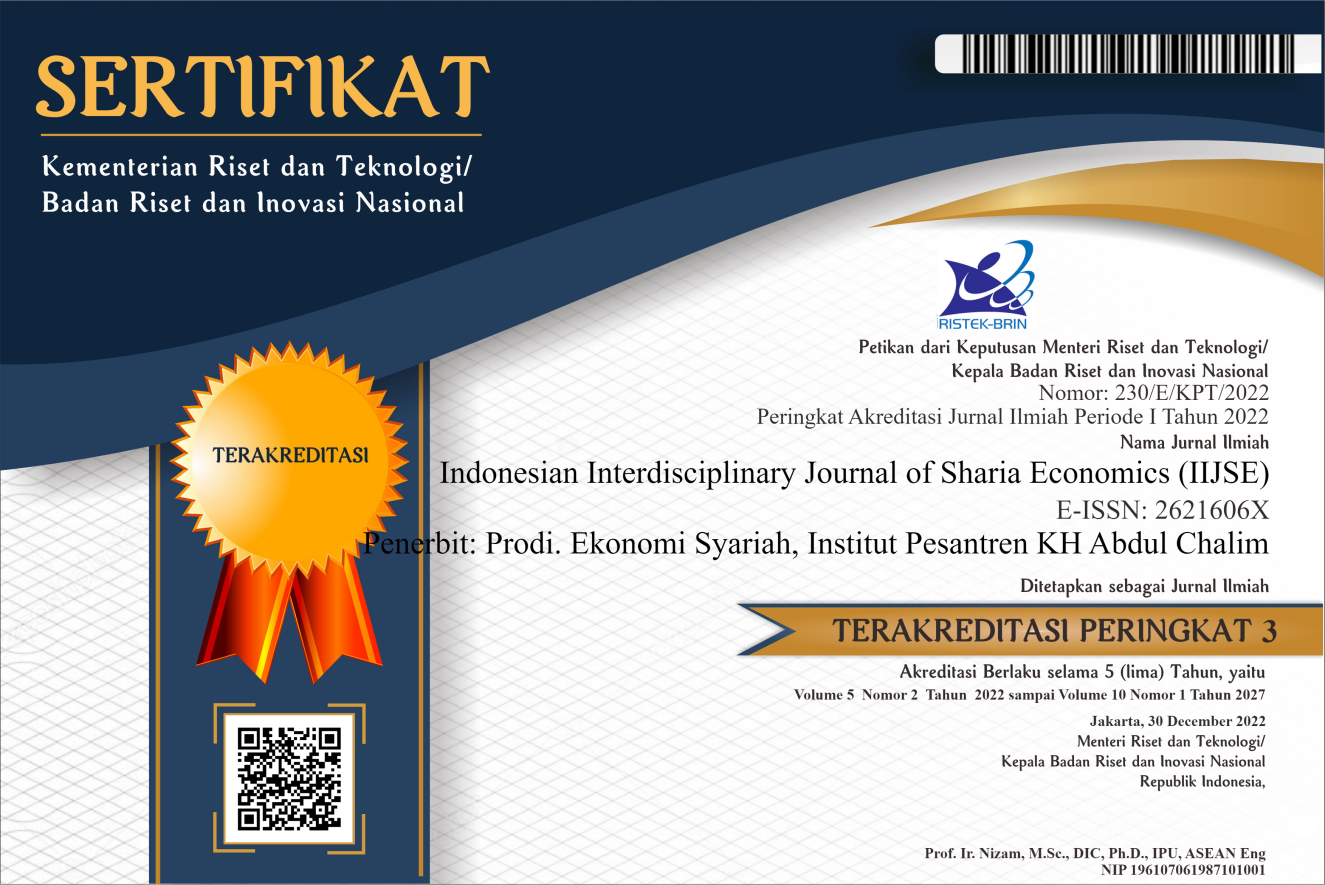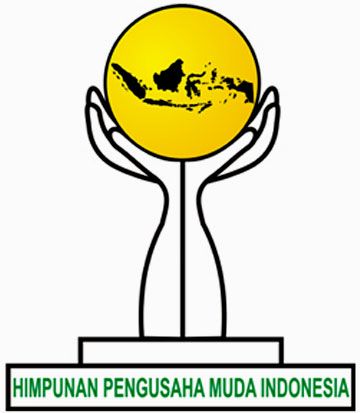Islamic Financial Inclusion and Economic Growth: Empirical Evidence from Indonesia
Abstract
This study aims to analyze the impact of Islamic financial inclusion on economic growth in Indonesia for the period 2018-2022. The research method uses a quantitative approach by utilizing secondary data per province in Indonesia, which is a combination of time series and cross-section (Panel Data) obtained from the OJK and BPS websites. Data analysis was conducted using multiple linear regression analysis using Eviews 10 software. The results of the analysis show that simultaneously, Islamic financial inclusion has a significant impact on economic growth. Furthermore, partially, it was found that third-party funds and Islamic bank financing contributed positively to economic growth. Meanwhile, Islamic financial access shows a negative impact on economic growth in Indonesia for the period 2018-2022.
Downloads
References
Adzimatinur, F., & Manalu, V. G. (2021). The Effect of Islamic Financial Inclusion on Economic Growth: A Case Study of Islamic Banking in Indonesia. Budapest International Research and Critics Institute (BIRCI-Journal): Humanities and Social Sciences, 4(1) 976-985. https://doi.org/10.33258/birci.v4i1.1699
Andriani, & Fitri Patika Sari. (2021). Dana Pihak Ketiga (DPK) dan Pembiayaan Akad Murabahah (Studi Pada PT. Bank Syariah Mandiri Periode 2014-2018) (The Third Party Fund (DPK) and Murabahah Akad Financing (Study at PT. Bank Syariah Mandiri Period 2014-2018. Qawãnïn Journal of Economic Syaria Law, 5(1) 83-100. https://doi.org/10.30762/qawanin.v5i1.3422
Anindyntha, F. A. (2020). Pengaruh Penerapan Inklusi Keuangan Terhadap Pertumbuhan Ekonomi di Indonesia. Jurnal Ilmu Ekonomi JIE, 4(1) 153-164. https://doi.org/10.22219/jie.v4i1.14900
Anwar, K., & Amri. (2017). Pengaruh Inklusi Keuangan Terhadap PDB Indonesia. Jurnal Ilmiah Mahasiswa. Universitas Syiah Kuala Banda Aceh. 13(1) 79-90. https://doi.org/10.21831/economia.v13i1.13323
Ayyubi, S. El, Anggraeni, L., & Mahiswari, A. D. (2017). Pengaruh Bank Syariah terhadap Pertumbuhan Ekonomi di Indonesia The Effect of Islamic Banking to Economic Growth in Indonesia Salahuddin. Al-Muzara’ah, 5(2) 88-106.
Azizah, A. N., Saragi, D. D., & Derin Tsa, Y. P. (2021). The Effect of Sharia Financial Inclusion on Indonesian Economic Growth. Dinamika Ekonomi, 12(2) 150-159. https://doi.org/10.29313/de.v12i2.7798
Bank Indonesia. (2014). Booklet Financial Inclusion. In Bank Indonesia.
Bonivia, T. Della, Aimon, H., & Satrianto, A. (2019). Pengaruh Financial Inclusion Terhadap Perekonomian Indonesia. Jurnal Kajian Ekonomi Dan Pembangunan, 1(3) 721-730. https://doi.org/10.24036/jkep.v1i3.7699
BPS. (2016). Produk Domestik Regional Bruto Kabupaten/Kota Di Indonesia 2018-2022. In BPS RI.
Dwi, I., & Jalungono, G. (2022). Analisis Faktor-Faktor yang Mempengaruhi Pertumbuhan Ekonomi Provinsi Jawa Tengah. Transekonomika: Akuntansi, Bisnis Dan Keuangan, 2(3)1-16. https://doi.org/10.55047/transekonomika.v2i3.122
Erlando, A., Riyanto, F. D., & Masakazu, S. (2020). Financial inclusion, economic growth, and poverty alleviation: evidence from eastern Indonesia. Heliyon, 6(10) 1-13. https://doi.org/10.1016/j.heliyon.2020.e05235
Febriaty, R. (2020). Pengaruh Inklusi Keuangan Pada Era Digital Economi Terhadap Pertumbuhan Ekonomi Indonesia. Seminar of Social Sciences Engineering & Humaniora, September 2018. 2(1) 205-221. http://dx.doi.org/10.21776/jdess.2023.02.1.19.
Fitriyanto, D. (2021). Financial Inclusion dan Pembiayaan Perbankan Syariah dalam Mempengaruhi Perkembangan UMKM Serta Dampaknya pada Pertumbuhan Ekonomi Indonesia. Journal of Economic and Bussiness, 1(4) 295-307. http://ejournal.ijshs.org/index.php/commo/article/view/292/235
Frita, N., Hamdani, I., & Devi, A. (2021). Pengaruh Inklusi Keuangan dan Bank Syariah terhadap Infrastruktur Nasional Dan Pertumbuhan Ekonomi Dalam Program SDGs. El-Mal: Jurnal Kajian Ekonomi & Bisnis Islam, 5(1) 155-182. https://doi.org/10.47467/elmal.v5i1.690
Hanivan, H., & Nasrudin, N. (2019). A financial inclusion index for Indonesia. Buletin Ekonomi Moneter dan Perbankan, 22(3) 1-26. https://doi.org/10.21098/bemp.v22i3.1056
Hidayanti, A. (2018). Pengaruh Inklusi Keuangan Syariah terhadap Pertumbuhan Ekonomi Indonesia tahun 2015-2017. Jurnal Ilmiah Mahasiswa Fakultas Ekonomi dan Bisnis Universitas Brawijaya. 1(2) 1-21
Iqbal, Z., & Mirakhor, A. (2014). Financial Inclusion : Islamic Finance Perspective. Journal of Islamic Business and Management, 2(1) 35-64. https://doi.org/10.12816/0004974
Jhingan, L. (2016). Ekonomi Pembangunan dan Perencanaan. Jakarta: PT Raja Grafindo Persada.
Khairul, A., & Amri, A. (2017). Pengaruh Inklusi Keuangan Terhadap PDB Indonesia. Jurnal Ilmiah Mahasiswa Ekonomi Pembangunan Fakultas Ekonomi dan Bisnis Unsyiah, 2(3), 454–462.
Kim, D. W., Yu, J. S., & Hassan, M. K. (2018). Financial inclusion and economic growth in OIC countries. Research in International Business and Finance, 43(9) 1-14. https://doi.org/10.1016/j.ribaf.2017.07.178
Lincolin, A. (2014). Ekonomi Pembangunan (Edisi 5). Yogyakarta: STIE YKPN.
Muhammad. (2015). Sistem dan Prosedur Operasional Bank Syariah. Yogyakarta: UII Press.
OJK. (2022). Laporan Perkembangan Keuangan Syariah Indonesia 2022. In Ketahanan dan Daya Saing Keuangan Syariah.
Prasetyo, P. E. (2019). Fundamental Makro Ekonomi: sebuah penegtahuan tingkat dasar dan menengah serta advanced untuk ilmu ekonomi makro. Yogyakart: Beta Offset.
Puspitasari, S., W. Mahri, A. J., & Utami, S. A. (2020). Indeks Inklusi Keuangan Syariah di Indonesia Tahun 2015-2018. Amwaluna: Jurnal Ekonomi Dan Keuangan Syariah, 4(2) 15-31.
Reyes, G. P. (2014). Financial Inclusion Indicators for Developing Countries. CGAP, 511.
Sanjaya, I. M., & Nursechafia, N. (2016). Financial Inclusion and Inclusive Growth: A Cross-Province Analysis In Indonesia. Buletin Ekonomi Moneter dan Perbankan, 18(3) 281-306. https://doi.org/10.21098/bemp.v18i3.551
Sarma, M., & Pais, J. (2012). Financial Inclusion and Development: A Cross Country Analysis. In Annual Conference of the Human Development and Capability Association, New Delhi, 16(8) 10-13. https://doi.org/10.1002/jid
Sukirno, S. (2016). Makroekonomi Teori Pengantar Edisi Ketiga (Edisi 3.). Rajawali Pers.
Todaro, M. P., & Smith, S. C. (2020). Pembangunan Ekonomi di Dunia Ketiga, (Edisi 13). Terjemahan Haris Munandar, Penerbit Erlangga, Jakarta.
Umar, A. I. (2017). Index Of Syariah Financial Inclusion In Indonesia. Buletin Ekonomi Moneter dan Perbankan, 20(1) 1-28. https://doi.org/10.21098/bemp.v20i1.726
Copyright (c) 2025 Ichsan Hamidi, Arip Hidayatul Fadillah, Abdul Bashir, Agung Saputra, Waldi Novi Yarsah

This work is licensed under a Creative Commons Attribution-ShareAlike 4.0 International License.
Authors who publish with this journal agree to the following terms:
- Authors retain copyright and grant the journal right of first publication with the work simultaneously licensed under a Creative Commons Attribution License that allows others to share the work with an acknowledgment of the work's authorship and initial publication in this journal.
- Authors are able to enter into separate, additional contractual arrangements for the non-exclusive distribution of the journal's published version of the work (e.g., post it to an institutional repository or publish it in a book), with an acknowledgment of its initial publication in this journal.
- Authors are permitted and encouraged to post their work online (e.g., in institutional repositories or on their website) prior to and during the submission process, as it can lead to productive exchanges, as well as earlier and greater citation of published work.


















